10 Health Goals You Can Easily Achieve in 2022, Say Dietitians

Instead of setting yourself a lofty weight loss goal, what if this year, you approached your New Year’s resolution a little differently? Losing weight isn’t the end-all-be-all for getting healthy, and can easily lead to unhealthy dieting practices down the line. So alternatively, what if you set a goal that encouraged living a healthier life rather than focusing on a number on the scale?
Eating a nutritious diet is about so much more than just losing weight. Your diet can affect your longevity, your risk of developing chronic diseases, and even your mood. And a nutritious diet doesn’t mean restriction—it means learning how to eat healthfully while still incorporating in all of the foods that you love into your life.
Sure, weight loss may come over time, but don’t let it be your only motivation. You’ll likely have moments where the number on the scale doesn’t budge—or you may even see fluctuations in your weight for all kinds of other reasons (bloating, menstruation, climate, illness, and many other factors could be at play).
Instead of getting frustrated by a number and giving up on your health when things “just aren’t working,” focus on other markers. How does this new healthy resolution make you feel? What are some of the positive physical changes you’re seeing (clear skin, less bloating, regular bowel movements, more energy)? How about the mental changes?
If this sounds like something you desire for your health this year, you’ve come to the right place. We asked a few dietitians to share some attainable healthy resolutions you can easily adopt in 2022 that will leave you feeling healthy, energized, and ready to take on the year ahead. No scale required.
Honor your body’s hunger and fullness cues.

Don’t wait for your body to get overly hungry or overly full. Dr. Rachel Paul, PhD, RD from CollegeNutritionist.com says to feed yourself when needed, and to stop when you’re no longer hungry.
“The hunger scale goes from 1 to 10, where 1 is starving, and 10 is super full,” says Paul. “Aim to stay in the 3 to 7 range, where you wait to eat until you’re hungry, and stop eating when you’re full. No food is ‘not allowed’ and you can always eat a certain food again, next time you’re hungry.”
Eat the rainbow every day.
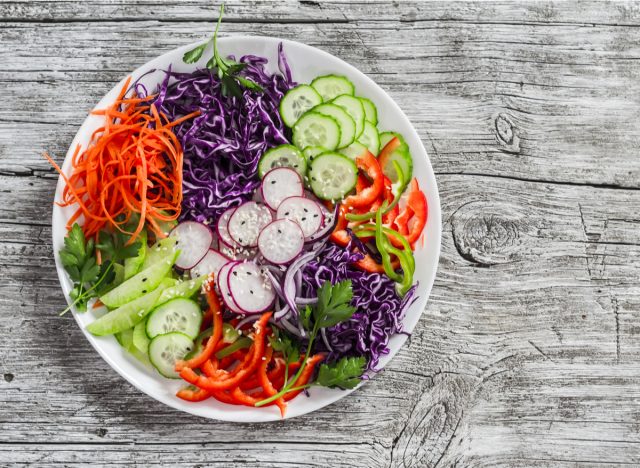
Who doesn’t love an eye-catching colorful plate of food? Incorporating a variety of colors on your plate is a great way to ensure you’re getting all kinds of nutrients in your diet, says Mackenzie Burgess, RDN and recipe developer at Cheerful Choices.
“All of these different colors represent different antioxidants, phytochemicals, and nutrients you need to support a healthy body,” says Mackenzie Burgess, RDN and recipe developer at Cheerful Choices.
Burgess says the colors are commonly broken up into five different categories: red, yellow and orange, green, purple and blue, and white.
“While it probably isn’t realistic to eat every color in one meal, try to incorporate these different colored foods throughout the week with the goal of eating as many as possible,” says Burgess.
Schedule exercise in your day.

“We all schedule work meetings, hair appointments, and dinner reservations on our calendars, why not exercise?” asks Amy Goodson, MS, RD, CSSD, LD, author of The Sports Nutrition Playbook and a member of our medical expert board. “‘I’ll exercise more’ sounds good, but often the hardest part is actually making it happen. So, make your goal to schedule exercise on your calendar and if you have a conflict, reschedule it, just like you would a work meeting.”
Goodson recommends setting your workout “appointment” three times a week at first. Once you start making those meetings regularly and feel good about it, you can add in another day or two.
“This is a fantastic way to tangibly make exercise a part of your life,” says Goodson.
Increase your fiber intake.
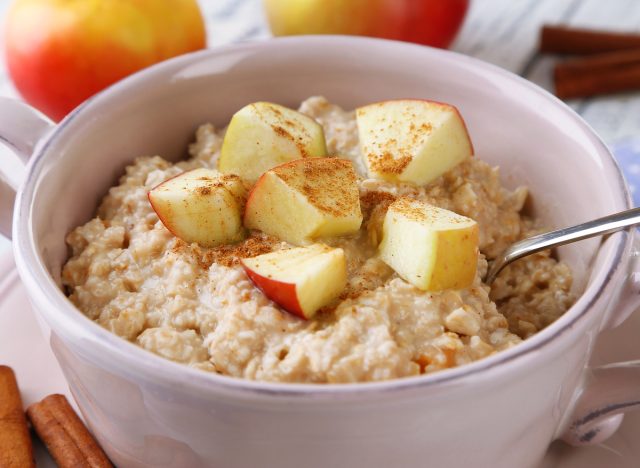
“While the recommendation is to eat 25 to 38 grams of fiber a day, the average American only eats about 10 to 13 grams,” says Goodson. “Fiber helps feed the good bacteria in your gut and certain types of fiber, soluble fiber, can help lower cholesterol. 25 grams may sound like a lot, but look for ways to add small amounts of fiber to each meal and snack.”
Goodson recommends fiber-rich foods like oatmeal for breakfast, apples for a snack, sandwiches made with 100% whole-grain bread, and stir-fry with half rice and half cauliflower rice.
“All these foods will help you increase your daily intake of fiber,” says Goodson.
Include a fruit or vegetable at each meal.
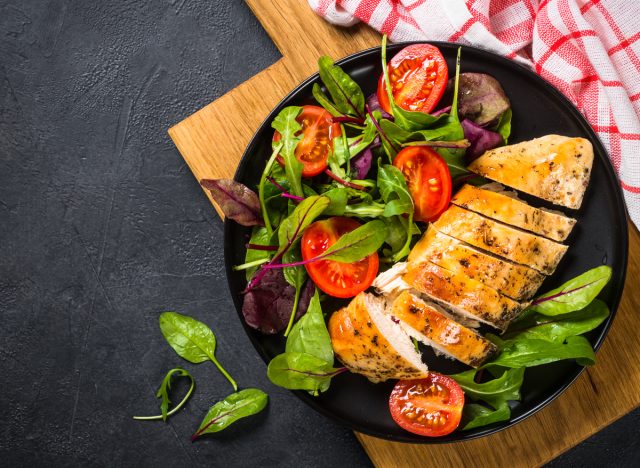
According to Lisa Young, PhD, RDN, author of Finally Full, Finally Slim and a member of our medical expert board, eating a nutritious diet isn’t about excluding foods and eating less.
“This tactic often backfires,” says Young. “The best way to eat less of an unhealthy food is to eat more of a healthy one.”
Instead, it’s about incorporating the right kinds of foods into a diet that makes sense for you. So what are those healthy foods to always incoporate into your meals? Fruits and vegetables!
“Focus on adding a fruit or a vegetable to each meal,” says Young. “Add a cup of berries to your oatmeal or enjoy an omelet with spinach and cheese for breakfast. At lunch, top your sandwich with avocado, lettuce, and tomato. At dinner, start with a vegetable soup or salad and enjoy a cooked vegetable like sauteed Bok choy or roasted cauliflower.”
Have a veggie at breakfast.

“Make it your resolution to make breakfast a little healthier and more unique than a bowl of cereal or eating a granola bar,” says Cheryl Mussatto MS, RD, LD, author of The Nourished Brain. “Why not include a fiber-filled, nutrient- and antioxidant-rich veggie as part of this meal? Considering that 90% of U.S. citizens are not meeting the Dietary Guidelines for Americans’ recommendation to eat 2 to 3 cups of vegetables each day, starting your day with a vegetable is an opportunity to squeeze one in.”
“For instance, add a handful of baby spinach to scrambled eggs or add a slice of tomato to your avocado toast,” Musatto continues. “Another fun idea is to stir grated zucchini into pancake batter or have a side of last night’s leftover roasted veggies alongside a whole grain muffin. And of course, yogurt-based smoothies are always perfect for adding in veggies like kale, cooked carrots, sweet potatoes, or even beets.”
Try a new fruit or vegetable each week.
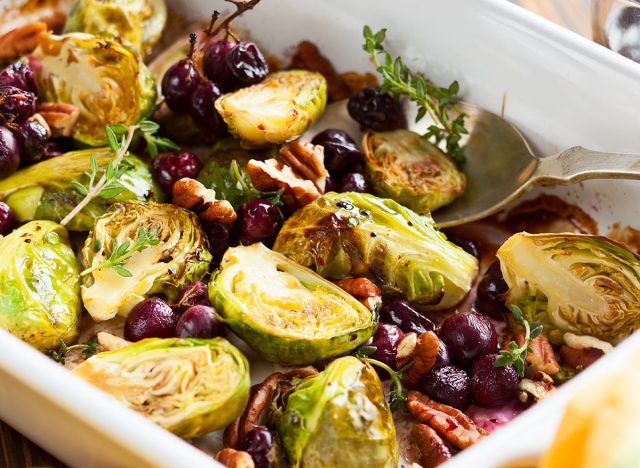
Not a fan of fruits or vegetables? Instead of doing a complete 180 this year, why not slowly work some into your diet over time? A great way to do this is by trying a new fruit or vegetable each week, and evaluating what you want to keep or not keep in your diet moving forward.
“Many of us have gotten stuck in our ways when it comes to the fruit and vegetables we’ve always eaten, but often don’t realize that our taste can mature and change over time,” says Trista Best, MPH, RD, LD, from Balance One Supplements. “By revisiting some old fruit or vegetables you didn’t like or trying new ones you can open up a whole new world of nutrient-dense foods.”
“If there is a vegetable you didn’t like before you can also opt to try a new cooking method,” Best continues. “If one new fruit or vegetable weekly is too much, allow yourself to introduce one every other week or on a monthly basis. By the end of 2022, you’ll be surprised to see how much variety you now have in your diet and new recipes you can integrate into your regular meal routine.”
Sweeten foods and drinks naturally.

“If you want to try to skip or limit the sugar in your drinks and baked goods, use honey as an alternative,” says Maggie Michalczyk, RDN, founder of OnceUponAPumpkinRD.com and author of The Great Big Pumpkin Cookbook. “Honey is a pure and natural sweetener with a wide array of vitamins, minerals, amino acids, and antioxidants. Just a drizzle can transform and elevate many different recipes, plus honey is a natural energy booster making it a great choice to add to a cup of tea.”
Prioritize your gut health.

“We continue to learn so much how the gut is connected to things like our digestion, mood, immune system, and more,” says Michalczyk. “If you’re looking to make simple health changes in the new year consider making small changes to benefit your gut. For example incorporating a probiotic into your routine, adding more fermented foods into your diet, or taking small steps to be less stressed out overall is all really beneficial for our gut health overall.”
Eat whole foods.
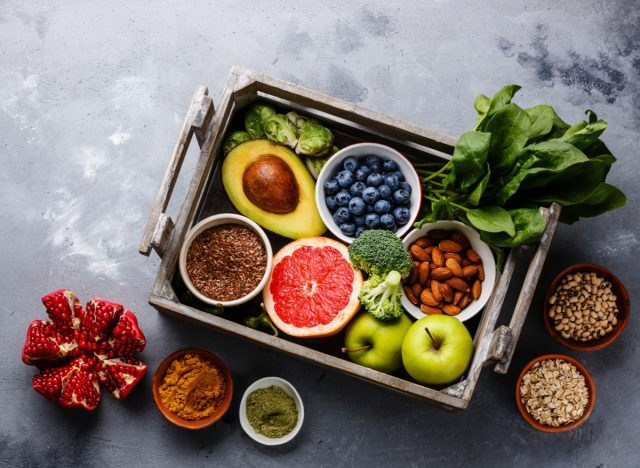
While packaged, processed foods can be convenient when you’re on the go, dietitians recommend that most of the time you focus on eating whole, real foods instead—the types of foods you would find in the perimeter of the grocery store.
“Excessive consumption of fast food is harmful to your health,” says Shannon Henry, RD with EZCare Clinic. “Although it is good in moderation, fast food can lead to obesity, heart strokes, and much more. For new year resolution, focus on eating less fast food and more whole foods—including vegetables, fruits, nuts and seeds, whole grains, and fish.”








